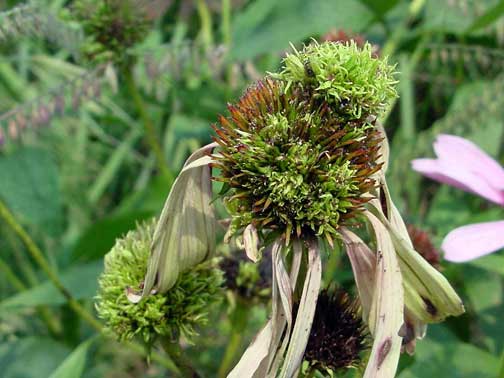
Aster yellows are a phytoplasma, which were previously considered a “mycoplasma-like organism” residing in the phloem (food-conducting tissues) of plants. The causative agent of aster yellows is Candidatus Phytoplasma asteris. Plants infected with aster yellows may exhibit a variety of symptoms including stunting, yellowing of foliage, witches’-broom (clumping of plant parts), abnormalities associated with flower parts, and greening of flower petals. Aster yellows are an insect-spread disease vectored primarily by the aster or the six-spotted leafhopper (Macrosteles fascifrons) but may also be vectored by other leafhoppers. The aster leafhopper acquires the phytoplasma when feeding on winter grain crops in the south. When the wheat or barley mature and are not a viable food source, leafhoppers leave grain fields and are carried northward by wind currents. This is how the leafhoppers are distributed throughout the Midwest, and other areas. Once the migrating leafhoppers find a suitable host plant they start feeding.
The leafhopper acquires the phytoplasma by inserting its mouthparts into the phloem cells of infected plants. After acquiring the phytoplasma, the incubation period takes several weeks before the leafhopper can serve as an efficient vector when feeding on susceptible host plants. When the leafhopper feeds on an un-infected plant, the phytoplasma is injected through the mouthparts (stylet) into the phloem. Afterward, the phytoplasma becomes established and multiplies. Infested plants typically exhibit symptoms after one to two weeks depending on temperature with symptoms being expressed sooner at temperatures between 68 and 72°F. Once a plant is infected it remains so throughout its entire life. The aster leafhopper may carry the disease over long distances as the insect migrates northward from the south and is able to transmit the disease throughout its entire life. The disease is entirely dependent on leafhoppers for transfer to plants. Several weeds and perennial plants may harbor aster yellows including chicory, dandelion, horseweed, thistle, and Queen Anne’s lace (which is a plant we recommend for attracting beneficial insects including parasitoids and predators into landscapes and gardens). In addition, the disease may overwinter in infected host plants or perennial weeds.
A wide-variety of horticultural plants grown in landscapes and gardens are susceptible to aster yellows including Aster, Centaurea (Bachelor’s-Button), Coreopsis, Delphinium, Echinacea (Purple Cone-Flower), Gladiolus, Limonium (Sea Lavender or Statice), Tagetes (Marigold), Phlox, Veronica, and Zinnia. Several vegetable crops are also susceptible to aster yellows such as broccoli, carrot, cauliflower, celery, lettuce, spinach, and tomato. The disease does not thrive in areas where the air temperature is greater than 90°F because high temperatures may inactivate the phytoplasma in both leafhoppers and infected plants.
Management of aster yellows primarily involves the following:
- Removing infected plants and weed hosts from the landscape or garden
- Removing any weed hosts from within and around the landscape and garden, which will help avoid the spread of the disease from weed reservoirs
- Selecting plants that are not susceptible to aster yellows
- Regulating leafhopper populations
Regulating leafhopper populations with contact insecticides is difficult because they are very mobile, move in from surrounding areas and feed on a variety of plant types. Strategically placing yellow sticky cards or tape around susceptible plants may be effective in capturing adults and reducing the potential for transmission of the phytoplasma. If aster yellows are a perennial problem in your landscape or garden, then it may be best and more efficient to utilize plants that are not hosts of the phytoplasma.
Raymond A. Cloyd is a Professor and Extension Specialist in Horticultural Entomology/Integrated Pest Management.
Related Articles & Free Email Newsletter Sign Up
Azadirachtin and Neem: What is the Difference?
Natural on the Label Doesn’t Always Mean Safe
Understanding the Proper Use of Adjuvants



Comment here